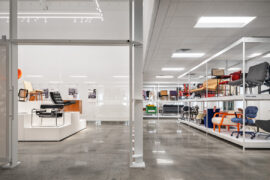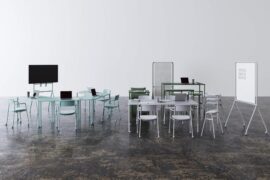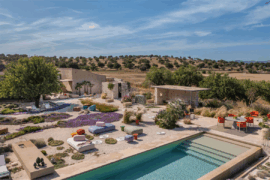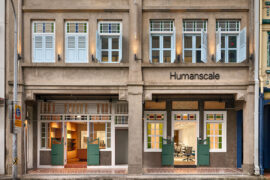Overcoming personal tragedy enabled Rachel Neeson to establish herself as one of Australia’s leading architects. We reflect on Neeson’s career having recently been announced as a 2019 INDE Luminary.
Even Rachel doubted if she could carry on the Neeson Murcutt practice following the death of Nick Murcutt in 2011.
“I wasn’t sure I could do it on my own,” she reflects. This is despite the fact they discussed all the design decisions together. But she had tended to be in the back room doing the documentation, with Nick the public face of the practice.
But do it she did, hauling the business back from the brink. In fact, she re-invented the practice. The Neeson Murcutt trademark tactility, elegance and sense of place is still a feature of the studio’s work, but Rachel has diversified the portfolio and re-built the company of 12-14 staff to greatly extend its capability.
Hence, they are working on a community hub and library for Broken Hill, plus schools work for Sydney Catholic Schools and Barker College. And, after designing an elegant and imposing new entry to the Australian Museum in Sydney, they are now working with Cox Architecture on a bold new interior space for the Museum.
“We always want to do houses,” she says, “because they are the hardest to crack. It is so complex to hold architecture together through a house. But we only do one at a time because they are so draining.”
There were projects already on the go when Nick died and Rachel saw them through to completion. Perhaps the most significant one – and the practice’s first public project – was Prince Alfred Park and Pool (2013), designed with landscape architect Sue Barnsley who continues to partner with Rachel on projects and acts as one of her closest confidantes.
It is an extraordinary re-imagining of an inner-city swimming pool, a celebration of urban green space with its native meadows and grassy berms, which Rachel points out provided the unexpected bonus of acoustic mitigation in a very noisy part of the city.
But for the Kempsey Surf Life Saving Club (2016) Rachel was on her own. Apart from an offhand comment from Stephen Neille (her new business and life partner – and a surfer) that it needed to be a “beachy thing”, it was uniquely her concept while maintaining the Neeson Murcutt knack for re-imagining existing typologies with creative planning and great sensitivity to materials.
This continues to be evident in recent houses such as the Coastal Garden House in Sydney (2018), but also in the public projects that are now increasingly defining the character of the practice. A perfect example of this is the Juanita Nielsen Community Centre (2017) in Sydney’s Woolloomooloo. It involved the adaptive re-use of an existing brick building and their approach, says Rachel, was “to make the building even older than it really was”.
Given the mixed demographic of this traditionally raffish harbourside suburb, it was a case of making people feel comfortable by creating the feeling that the place “has been around for a while”. It was designed, says Rachel, to be non-confrontational, with special consideration given to the acoustics in consideration of its elderly patrons.
Stand by – because the best of Rachel Neeson is probably still to come.
INDESIGN is on instagram
Follow @indesignlive
A searchable and comprehensive guide for specifying leading products and their suppliers
Keep up to date with the latest and greatest from our industry BFF's!

The undeniable thread connecting Herman Miller and Knoll’s design legacies across the decades now finds its profound physical embodiment at MillerKnoll’s new Design Yard Archives.

Welcomed to the Australian design scene in 2024, Kokuyo is set to redefine collaboration, bringing its unique blend of colour and function to individuals and corporations, designed to be used Any Way!

Building on its beginnings in Melbourne Design Week, A New Normal is a new exhibition presented by Vivid Ideas Sydney at Powerhouse Ultimo.

In Australia alone, 6.4 per cent of all waste generated comes from furniture and furnishings. In this article, we review today’s most impactful Whole Of Lifecycle Furniture practices.
The internet never sleeps! Here's the stuff you might have missed

Entertaining outdoors is fundamental to Italian culture, and homes, hotels and restaurants embrace patios, terraces and gardens that celebrate scenery, climate and comfort.

Humanscale’s new showroom is about the modern workplace, with ergonomic excellence, sustainable design and architectural heritage in Singapore.